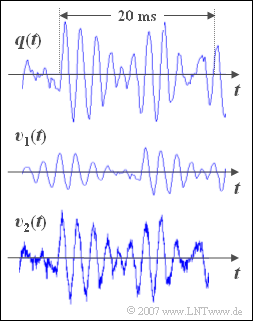Difference between revisions of "Aufgaben:Exercise 1.1: Music Signals"
From LNTwww
| Line 1: | Line 1: | ||
{{quiz-Header|Buchseite=Signaldarstellung/Prinzip der Nachrichtenübertragung}} | {{quiz-Header|Buchseite=Signaldarstellung/Prinzip der Nachrichtenübertragung}} | ||
| − | [[File:P_ID339__Sig_A_1_1.png|right|frame|Music signals, original | + | [[File:P_ID339__Sig_A_1_1.png|right|frame|Music signals, original, <br> noisy and/or distorted?]] |
On the right you see a ca. $\text{30 ms}$ long section of a music signal <math>q(t)</math>. It is the piece „For Elise” by Ludwig van Beethoven. | On the right you see a ca. $\text{30 ms}$ long section of a music signal <math>q(t)</math>. It is the piece „For Elise” by Ludwig van Beethoven. | ||
| Line 70: | Line 70: | ||
*The signal <math>v_1(t)</math> is undistorted compared to the original signal <math>q(t)</math>. The following applies: $v_1(t)=\alpha \cdot q(t-\tau) .$ | *The signal <math>v_1(t)</math> is undistorted compared to the original signal <math>q(t)</math>. The following applies: $v_1(t)=\alpha \cdot q(t-\tau) .$ | ||
| − | * | + | *An attenuation <math>\alpha</math> and a delay <math>\tau</math> do not cause distortion, but the signal is then only quieter and comes later than the original. |
| − | '''(3)''' | + | '''(3)''' Correct are the <u>solutions 1 and 3</u>: |
| − | * | + | *One can recognize both in the displayed signal <math>v_2(t)</math> and in the audio signal ''additive noise'' ⇒ <u>solution 3</u>. |
| − | * | + | *The signal-to-noise ratio is approx. $\text{30 dB}$; but this cannot be seen from this representation. |
| − | * | + | *Correct is also the <u>solution 1</u>: Without this noise component <math>v_2(t)</math> identical with <math>q(t)</math>. |
| − | '''(4)''' | + | '''(4)''' The signal <math>v_1(t)</math> is identical in form to the original signal <math>q(t)</math> and differs from it only |
| − | * | + | *by the attenuation factor $\alpha = \underline{\text{0.3}}$ (dies entspricht etwa $\text{–10 dB)}$ |
| − | * | + | *and the delay $\tau = \underline{10\,\text{ms}}$. |
{{ML-Fuß}} | {{ML-Fuß}} | ||
__NOEDITSECTION__ | __NOEDITSECTION__ | ||
[[Category:Aufgaben zu Signaldarstellung|^1. Grundbegriffe der Nachrichtentechnik^]] | [[Category:Aufgaben zu Signaldarstellung|^1. Grundbegriffe der Nachrichtentechnik^]] | ||
Revision as of 13:15, 8 August 2020
On the right you see a ca. $\text{30 ms}$ long section of a music signal \(q(t)\). It is the piece „For Elise” by Ludwig van Beethoven.
- Underneath are drawn two sink signals \(v_1(t)\) and \(v_2(t)\), which were recorded after the transmission of the music signal \(q(t)\) over two different channels.
- The following controls allow you to listen to the first fourteen seconds of each of the three audio signals \(q(t)\), \(v_1(t)\) and \(v_2(t)\).
Originalsignal \(q(t)\)
Sinkensignal \(v_1(t)\)
Sinkensignal \(v_2(t)\)
Notes:
- The task belongs to chapter Prinzip der Nachrichtenübertragung.
Questions
Solutions
(1) Correct is the solution 2:
- In the marked range of $20$ milliseconds approx. $10$ oscillations can be detected.
- From this the result follows approximately for the signal frequency; $f = {10}/(20 \,\text{ms}) = 500 \,\text{Hz}$.
(2) Correct is the solution 1:
- The signal \(v_1(t)\) is undistorted compared to the original signal \(q(t)\). The following applies: $v_1(t)=\alpha \cdot q(t-\tau) .$
- An attenuation \(\alpha\) and a delay \(\tau\) do not cause distortion, but the signal is then only quieter and comes later than the original.
(3) Correct are the solutions 1 and 3:
- One can recognize both in the displayed signal \(v_2(t)\) and in the audio signal additive noise ⇒ solution 3.
- The signal-to-noise ratio is approx. $\text{30 dB}$; but this cannot be seen from this representation.
- Correct is also the solution 1: Without this noise component \(v_2(t)\) identical with \(q(t)\).
(4) The signal \(v_1(t)\) is identical in form to the original signal \(q(t)\) and differs from it only
- by the attenuation factor $\alpha = \underline{\text{0.3}}$ (dies entspricht etwa $\text{–10 dB)}$
- and the delay $\tau = \underline{10\,\text{ms}}$.
